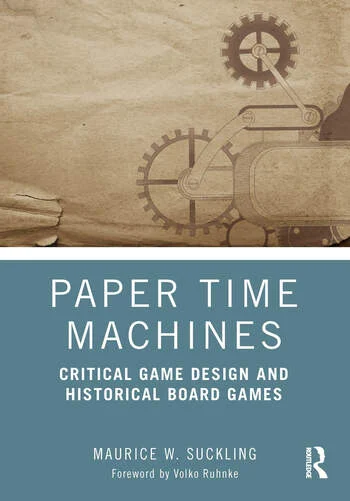Gostava de ter acesso a estes livro “Paper Time Machines Critical Game Design and Historical Board Games” de Maurice W. Suckling.
Do autor surge o seguinte texto:
“James Dunnigan’s memorable phrase serves as the first part of a title for this book, where it seeks to be applicable not just to analog wargames, but also to board games exploring non-expressly military history, that is, to political, diplomatic, social, economic, or other forms of history. Don’t board games about history, made predominantly out of (layered) paper, permit a kind of time travel powered by our imagination? Paper Time Machines: Critical Game Design and Historical Board Games is for those who consider this a largely rhetorical question; primarily for designers of historical board games, directed in its more practice-focused sections (Parts Two, Three, and Four) toward those just commencing their journeys through time and space and engaged in learning how to deconstruct and to construct paper time machines.
More experienced designers may find something here for them, too, perhaps to refresh themselves or as an aid to instruction to mentees in whatever capacity. But it is also intended for practitioners of all levels of experience to find value in the surrounding historical contexts and theoretical debates pertinent to the creation of and the thinking around the making of historical board games (Parts One and Five). In addition, it is intended that the book might redirect some of the attention of the field of game studies, so preoccupied with digital games, toward this hitherto generally much neglected area of research.
Key Features:
Guides new designers through the process of historical board game design
Encapsulates the observations and insights of numerous notable designers
Deeply researched chapters on the history and current trajectory of the hobby
Chapters on selected critical perspectives on the hobby.”
E tem como capítulos:
Chapter 1: Introduction
Part One: Context
Chapter 2: What Is Critical Game Design?
Chapter 3: What Are Historical Simulations?
Chapter 4: A Brief History of Board Wargames
Chapter 5: A Briefer History of Pol-Mil Wargames
Chapter 6: An Even Briefer History of Non-Wargame Historical Board Games
Part Two: Design Process & Tools
Chapter 7: Overall Process
Chapter 8: Devising A Thesis
Chapter 9: Common Components & Major Mechanics
Chapter 10: Major Card Functions & Metaphors
Chapter 11: Board Design
Chapter 12: Development & Publication
Part Three: Designing Historical Board Wargames
Chapter 13: Historical Board Wargame Design: Reference Books & Conventions Overview
Chapter 14: Design Conventions: Units
Chapter 15: Design Conventions: Combat Resolution
Chapter 16: Design Conventions: Movement, Morale, & More
Chapter 17: Design ‘Unconventions’
Part Four: Designing Non-Wargame Historical Board Games
Chapter 18: Case Study #1: Operation Barclay
Chapter 19: Case Study #2: Crisis: 1914
Chapter 20: Case Study #3: Peace 1905
Part Five: Selected Critical Topics
Chapter 21: Two Unsolvable Problems in Historical Board Game Design
Chapter 22: War Stories: Storytelling and Wargame Design
Chapter 23: The Postcolonial Turn
Chapter 24: Paper Beats Silicon
+infos(oficial): LINK

